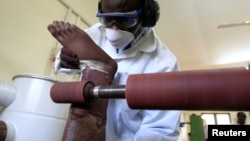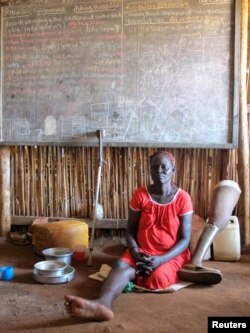Solomon was just 7 years old when he woke up missing a leg.
And he was one of the lucky ones.
Weeks later, Solomon was back on two feet with the aid of an artificial leg, fitted at a hectic hospital, turned into a limb-making factory, in the South Sudanese capital of Juba.
The hospital is in horribly high demand in a country born of war that remains littered with mines and explosive devices, with civil war still raging all around.
Most of South Sudan’s estimated 60,000 amputees have suffered war-related injuries, be it gunshot or landmine wounds.
As civil war devastates the world’s youngest country — it celebrates its sixth anniversary next month — it has become increasingly difficult for amputees to gain good treatment.
Second chance
Solomon came to his first artificial limb after an open fracture turned into a life-threatening infection, which forced doctors to amputate.
When he woke from surgery in a remote hospital in South Sudan’s Bentiu, he was far away from the capital with little chance of rehabilitation or help adjusting to his new life.
“I was put on a flight to Juba, where I am receiving a new, artificial leg,” he told the Thomson Reuters Foundation from his current home at the Physical Rehabilitation Reference Center.
It is the country’s biggest hospital for prosthetic orthotic treatment, treating about 30 patients a day.
“Amputations have gone up since the beginning of the civil war in 2013, but even with increased need, access to some areas is impossible due to active fighting and many people who have lost limbs might never be able to get out and receive help,” said Emmanuel Lobari, who as head of technicians oversees the production of all the prosthetic limbs.
Both hospital and factory, the center produces an average of 50 prostheses each month — all hand-made and custom fit.
Durable, affordable
“We use polypropylene to make the limbs, a material that has proved to be both durable and affordable,” physiotherapist Daniel Odhiambo said.
A Kenyan, he is one of a handful of expatriate staff at the hospital, employed by the International Committee of the Red Cross (ICRC).
“The prostheses last for an average of two years and it’s usually the foot, made out of a softer material, that wears out the fastest. The leg itself can last up to 10 years.”
Making a limb — from melting the plastic-like polypropylene to shaping it into a leg — is a quick process in the hospital’s small, modern factory and can be done within a day.
“It’s the fitting and the patient’s adaption that take up to 10 days,” Lobari said.
Lobari is South Sudanese, like most of the hospital’s 30 staff, all of whom received Red Cross training.
The organization first started treating amputations in 1979 during Ethiopia’s civil war, and developed the polypropylene technology that has since spread across all conflict zones.
Odhiambo has worked in many places, including Afghanistan, Yemen and Iraq. He recently took up his second mission in Juba.
“Here in South Sudan, I mainly see war wounds and they are very different from civilian wounds,” he said.
Nearly 250,000 mines and explosive devices were found and destroyed in South Sudan so far in 2017, according to the United Nations Mine Action Service (UNMAS). South Sudan slipped into civil war in 2013, two years after becoming independent from Khartoum, and some 4 million people, one third of the population, have fled to neighboring countries in its wake.
For those left behind, risk is part of daily life. The worst case Odhiambo has seen is an 18-year-old boy, who was brought to the clinic with both legs blown off by a landmine, pieces of muscle hanging out of the wound and shrapnel fragments stuck deep in his flesh.
“He was in consistent pain and it took months to build the right prosthesis, but I stayed with him through the whole process. I told him not to give up. He had his whole life ahead of him still.”
A resilient nation
Simon has been coming to the hospital for several months and can still vividly recall the day he was attacked, when several bullets were shot through his leg.
“I thought I was going to die, but my family took me to a small hospital where my leg was amputated,” he said.
Simon is from the north of the country then moved to Juba to get better care.
Three in four patients at the center are male. The women and children at the hospital underwent amputations after suffering different traumas, such as war injuries, crocodile bites, road accidents or infections.
It helps patients such as Solomon, just starting a new life with his first prosthesis, to meet older patients like Simon.
“The boy is still young, but he can see that he’s not alone with his injury,” Odhiambo said.
“The one difference I’ve noted working in South Sudan is that people here accept their fate easier than any others. They are resilient and want to go on with their lives. I even see it in Solomon,” Odhiambo said. “People have suffered, but they don’t lose their drive and motivation.”









